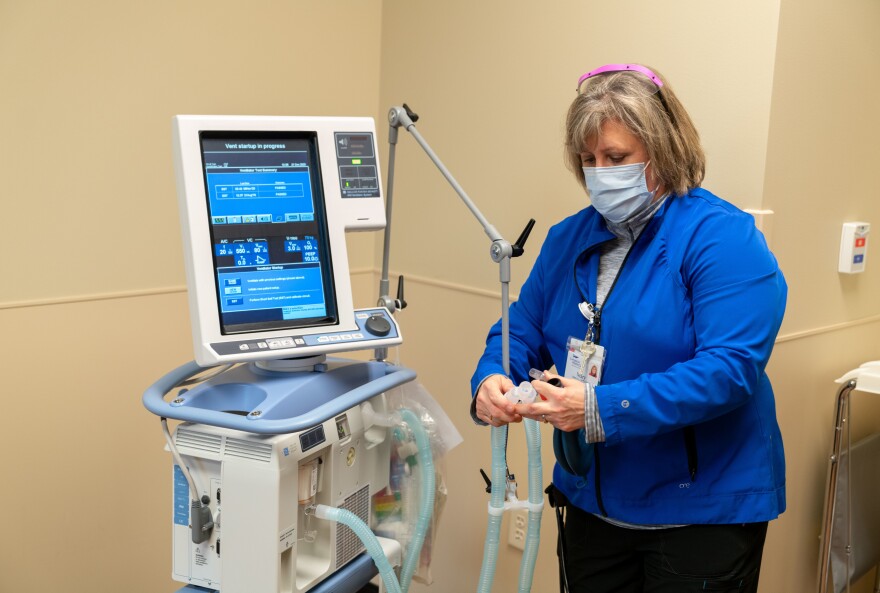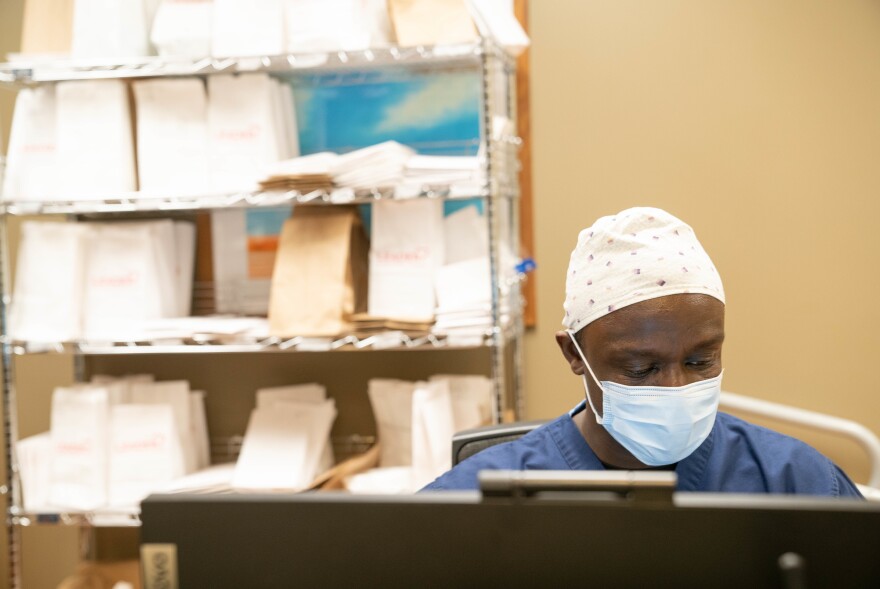When the coronavirus hit the U.S., hospitals issued strict limitations on visitors. Nurses and doctors started acting as liaisons to the sick and dying for family members not allowed at bedsides. As deaths reach new daily highs, that work is not getting any easier. The emotional toil of adapting to new dynamics with patients and families at one rural hospital in Livingston, Mont., is a case study of what health care workers are grappling with all over the country
Framed by the rugged Absaroka Mountains in south-central Montana, Livingston HealthCare looks more like an upscale ski chalet than a medical facility. It's in the U.S., which are federally designated to increase health care access in rural areas. Here, the hospital has 25 beds and serves a huge region — about twice the size of Rhode Island — but .

It's about an hour drive north of Yellowstone National Park, and the walls are dotted with images of trout and breathtaking vistas.
On this windy, wintry mid-December day, three beds here are occupied by COVID-19 patients.
End-of-life care
Jenn Schmid, the assistant director of nursing, is standing outside large windows that offer a view inside the hospital's two ICU rooms. This is the epicenter of the pandemic in the hospital — where the worst cases are. The beds are empty and neatly made. Soft, yellow light is pouring in from outside. But a few weeks ago, the scene here would have looked very different. Over the past several months, cases in the area ebbed and flowed — and they were in the midst of the biggest spike they'd seen so far.
"My job consisted of 24/7 begging people to try to come in to get help, coming in to try to staff it myself, just because we didn't have enough nurses," Schmid says.
The CDC recommends that hospitals limit visitation, especially during times of community spread. Figuring out how to do so requires balancing safety with the emotion and trauma faced by patients and their families.
Here, the hospital banned visitors, but there are exceptions. When patients near the end of their lives, their closest relatives are allowed to say their goodbyes from a distance — through those windows that look into the ICU. Schmid sat outside the room with families. She says that glass barrier between patients and their loved ones made farewells an even more emotionally devastating experience.
"Having to sit out here with family and try to be their support and give them that affection or that caring when you yourself have to stay 6 feet away and they can't see their dad or their husband for the last time and you have to watch that, it's gut-wrenching," she says. "And I don't think I'll ever get used to that. I've seen a lot of death and I've held multiple peoples' hands while they're dying. But I've never had anything that has affected me like that. It's so foreign. And it's tragic."

Respiratory therapist Mary Graham says all 265 health care workers at the hospital are taking on more responsibility to care for patients. "The hardest thing is watching them go without their family members," she says.
She's been in the room twice when this happened. She says she holds the patient's hand and says a prayer. She hopes that can give families an ounce of closure. "It's tough," she says.
Patients and families

Doctors and nurses experience that isolation very differently than patients and family members, who maintain connection with each other only through screens and glass. Last month, Lori Schmidt's husband Jerry was in one of those ICU rooms.
"If I had known that I would never get to hold his hand or anything again, oh my gosh, I would've done things so differently," Schmidt says. "But I guess naively I really didn't think Jerry was gonna die from this."
She's 59, a retired banker, and calls herself a "glass-half-full" kind of person. Her husband was 74.

"He was an amazing man," she says. "He could build, fix, wire. He was an electrician. He could do anything — he could rebuild a Mustang from start to finish."
One night in early November, her husband fell down in their house. He had a fever and was throwing up. She called the paramedics, who took him to the hospital. It was the last time she saw him face-to-face.
Schmidt says at Livingston HealthCare, nurses would call her from her husband's cellphone on Facetime.
"When Jerry pops up on my phone, there's a big daisy and when I would see that, no matter how bad I felt, I felt renewed," she says. "It was like 'Jerry's calling!' I was so excited."
With her husband in isolation, it was the closest she could get to human contact. When it became clear it was the end, the hospital brought the family into the ICU, where they could see Jerry through the window.
She says nurses were at his side. They sang him songs to help him feel at ease, and helped relay what Schmidt and her family were saying.
"[They were] trying to make him feel like he didn't have to hold on anymore because he was so tired," she says.
Schmidt says Jerry passed peacefully on Nov. 15 after 12 days in the hospital. As we talk, it's been one month, to the minute, since his death.
Schmidt's thankful for the health care workers who made sure her husband felt less isolated. Screens, windows, and all the small efforts of health care workers are a saving grace for Schmidt and people like her.
"I mean that made all the difference in the world."
Bedside manner

"Nursing is touching and interaction," says Per Gunness, an ICU and medical surgical nurse at Livingston HealthCare. "To hide the part of your face which shows your emotions, your intentions, your fear, your humor. You try to smile really hard so your eyes show it. That's been incredibly bizarre."
Health care workers layer up in masks, protective glasses, and other gear to stave off the spread of the disease. Instead of smiles and facial expressions, only their eyes — perched above an N95 — can show emotion and establish connection.
"It makes me sick to my stomach thinking about that, like, so many people are dying alone and their nurse has maybe known 'em or a couple of days is the last person they see," medical floor nurse Kristy Blaine says.
She says she recognizes the emotional work it takes to keep patients feeling connected.

"You also, you know, feel bad for your patients because these Martians are coming in, looking so different," Blaine says. "You know, you literally look like an alien and you're trying to care for your patients, and they just feel like lepers."
Blaine does what she can to make the hospital feel less sterile for her patients. She keeps a squishy, pink-haired unicorn dangling from a keychain on her ID badge. When you squeeze it, she demonstrates, a little brown bubble forms on its backside.
"It poops," she whispers, laughing." I like to joke around and I like to have fun and I feel like we all only get one trip on this Earth and it might as well be part of a good old laugh. You know nurses always ask about poop."
Blaine says that for nurses, adaptability is part of the job description. With only eyes peering out behind a mask, that pooping unicorn is one way of bringing joy into a world of isolation.
Limits on visitations in hospitals across the country are unlikely to change much until this spring or summer, when vaccines are widely available. Until then, health care workers will continue to adapt, to innovate, and to find reasons to smile.
Copyright 2020 Montana Public Radio. To see more, visit . 9(MDAxNDQ2NDAxMDEyNzU2NzM2ODA3ZGI1ZA001))


